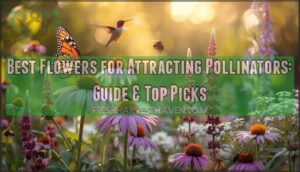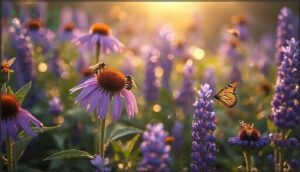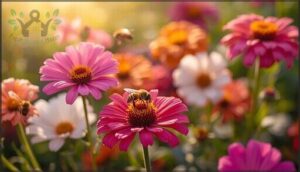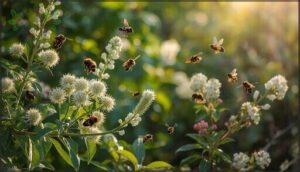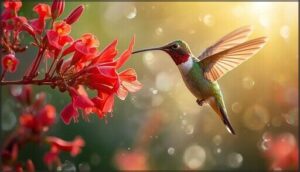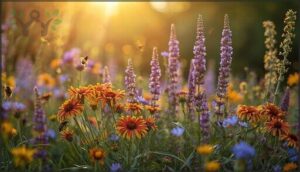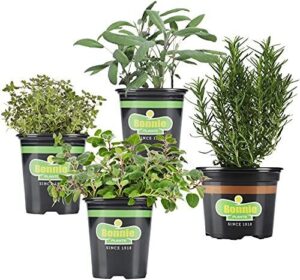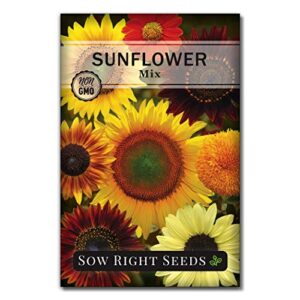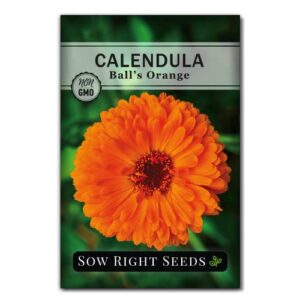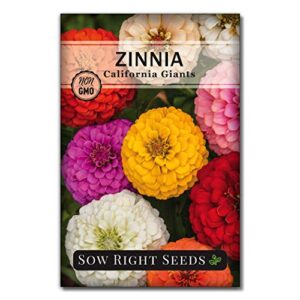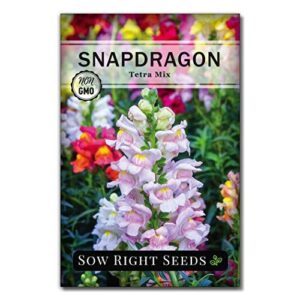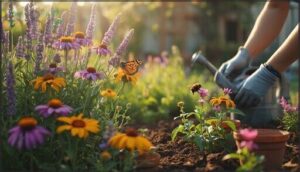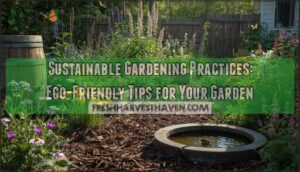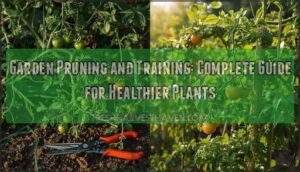This site is supported by our readers. We may earn a commission, at no cost to you, if you purchase through links.
Your garden might be bursting with blooms, but if pollinators aren’t showing up, you’re missing half the show. The difference between a flower that gets ignored and one that draws crowds of bees, butterflies, and hummingbirds comes down to a few key traits: open centers for easy nectar access, colors that match pollinator vision, and bloom times that fill seasonal gaps.
When you choose the best flowers for attracting pollinators, you’re not just adding pretty petals—you’re creating a lifeline for species that need continuous food sources from early spring through fall. Get the plant selection right, and you’ll transform your yard into a thriving hub where native bees, monarchs, and hummingbirds fuel up for migration, reproduction, and survival.
Table Of Contents
- Key Takeaways
- Key Traits of Pollinator-Attracting Flowers
- Best Flower Types for Pollinators
- Top 5 Flower Products for Pollinator Gardens
- Planting and Maintaining a Pollinator-Friendly Garden
- Frequently Asked Questions (FAQs)
- Which plants are best for Pollinator gardens?
- Which plants attract more pollinators?
- How do you attract pollinators to your garden?
- Why should you add plants that attract pollinators?
- What makes a good pollinator-Friendly Garden?
- Do spring flowers attract pollinators?
- What is the number one flower that attracts butterflies?
- Which flower colors best attract pollinators and birds?
- When should I start planting pollinator flowers?
- How much space do pollinator gardens need?
- Conclusion
Key Takeaways
- Choose flowers with open centers, bright colors (especially blue, purple, and red), and staggered bloom times from early spring through late fall to provide continuous nectar and pollen sources that keep pollinators fed year-round.
- Native plants matter most because about 35% of North American bees depend on specific native hosts for reproduction, so aim for roughly 70% natives in your garden while using non-natives strategically to fill seasonal gaps.
- Plant pollinator-friendly flowers in clusters at least three feet across rather than scattering them—this creates visual cues that boost foraging efficiency and helps bees collect more nectar per trip.
- Skip the pesticides entirely and provide essentials beyond flowers like shallow water dishes with stones, bare ground patches for nesting (70% of native bees nest in soil), and host plants like milkweed that support complete pollinator life cycles.
Key Traits of Pollinator-Attracting Flowers
Not all flowers are created equal in attracting pollinators. Certain traits make some blooms irresistible to bees, butterflies, and hummingbirds, while others get overlooked entirely.
Let’s look at the key features that turn your garden into a pollinator hotspot.
Open Centers and Easy Access to Nectar
When you’re choosing flowers that really work for pollinators, think about the shape first. Open-centered blooms are like a welcome mat for bees, butterflies, and flies—no secret passwords needed. Here’s why they’re pollinator magnets:
- Short-tongued bees and flies can’t reach nectar in tubular flowers, but open centers let everyone feast.
- Nectar production can be 10 times higher in cultivars with easy access.
- Late-season open flowers fill critical gaps when other nectar sources decline.
- Pollinator diversity skyrockets because more species can actually feed.
Bees are especially drawn to flowers, with blue or yellow petals being particularly attractive.
Bright Colors and Pollinator Preferences
Color matters more than you might think when attracting pollinators. Bees love blue and purple flowers most—field studies show blue blooms get nearly twice the visits of white ones. Butterflies go for yellow, pink, and red hues, while hummingbirds can’t resist red tubular flowers.
Many blossoms also have UV patterns invisible to us but irresistible to bees, acting like landing strips to boost visitation rates. Consider how pollinators see colors to improve your garden design.
Fragrance and Flower Shape
Beyond color, scent and shape work together to draw in specific pollinators. Fragrance intensity can triple hawkmoth visits, while different volatiles shift traffic between bumblebees and hummingbirds. Corolla morphology determines who gets in—tube depth and width control nectar access based on tongue length. Pollinator-friendly plants coordinate these signals:
- Narrow tubes paired with strong scent attract long-tongued specialists
- Open bowls with mild fragrance welcome generalist bees
- Night-blooming fragrant foliage draws moths
- Zygomorphic flowers guide precise pollen placement
This scent-signal coordination and shape-nectar access matching explain why certain flower characteristics succeed at attracting pollinators.
Seasonal Bloom Times for Continuous Support
Once scent and shape do the talking, timing seals the deal. Succession planting and bloom time overlap keep your garden buzzing from early spring through late-season blooms—because a June gap leaves pollinators scrambling. Extension guidelines suggest at least one to three species per bloom period (early, mid, late) for continuous floral resources.
Here’s how to plan planting for continuous blooms:
| Season | Example Blooms | Pollinator Benefit |
|---|---|---|
| Early Spring | Crocus, Willow | Wakes mining bees, sustains emerging queens |
| Mid-Summer | Lavender, Coneflower | Bridges gap, feeds active colonies |
| Late-Summer | Goldenrod, Aster | Fuels overwintering prep, final broods |
| Overlap Zones | Yarrow + Anise Hyssop | Prevents forage dips between waves |
| Year-Round | Mixed families (Asteraceae, Apiaceae) | Hosts 8–15 bee species vs. 3–5 without planning |
Seasonal gap avoidance through native bloom periods and strategic overlap can triple mid-season pollinator activity. A bloom calendar helps you map flowering windows, spot coverage holes, and weave in bridge species that turn a quiet garden into a year-round pollinator hub.
Native Vs. Non-Native Plant Benefits
Although both native and non-native flowers can attract pollinators, native plant specialization matters most. About 35% of North American bees rely on specific native hosts for reproduction, and surveys show native-dominated gardens support richer pollinator diversity.
Native plants matter most because 35% of North American bees depend on them to reproduce
Non-native forage can fill seasonal gaps when chosen carefully, but ecosystem resilience depends on native plant selection. Aim for roughly 70% natives in pollinator-friendly plants for balanced, thriving pollinator gardens.
Best Flower Types for Pollinators
Now that you know what makes a flower irresistible to pollinators, let’s look at specific plants that deliver. Some favorites are perennials that come back year after year, while others are annuals that pack a seasonal punch.
We’ll also cover shrubs, hummingbird magnets, and a few underrated gems that pollinators can’t resist.
Top Perennials for Bees and Butterflies
If you’re looking to support bees and butterflies, perennial plants like Purple Coneflower and Anise Hyssop are your best bet. These pollinator plants offer reliable nectar composition with varying sugar concentration that keeps visitors coming back.
Native benefits shine here—species adapted to your region naturally support more pollinators. Plus, cultivar variation matters: ‘Big Sky Sundown’ Echinacea attracts noticeably more bees, and staggered blooming patterns guarantee continuous food sources.
Favorite Annual Flowers for Pollinators
Zinnias and cosmos top garden recommendations because they deliver outstanding nectar production—Minnesota trials showed these annual plants rack up three to five times more pollinator visits than marigolds.
You’ll attract syrphid flies alongside bees, with some annual cultivars like ‘Pazzaz Red Flare’ portulaca hitting nearly one visit per minute.
Annual plant varieties fill important landscape roles, bridging gaps between perennial blooms when your pollinators need fuel most.
Shrubs and Regional Native Options
Native shrubs punch above their weight, offering more nectar per plant than most perennials while blooming earlier to support emerging bees. Buttonbush and summersweet deliver summer-long food sources across regions, and winterberry kicks off spring with butterfly-friendly blooms.
You’ll strengthen pollinator populations and cut agricultural costs by choosing regional native plants like manzanita in the Southwest or white turtlehead in the Northeast.
Flowers That Attract Hummingbirds
Hummingbirds zero in on tubular shapes and red flowers that match their high-speed hovering style. These tiny dynamos need nectar volume—about 5 to 18 µl per bloom—to fuel their metabolism, so your pollinator garden should include:
- Cardinal flower and salvias for intense red tubular blooms
- Bee balm and fuchsia hybrids for mid-to-late summer nectar
- Cuphea as a reliable annual through fall
- Columbine to jumpstart seasonal blooms in spring
Stagger bloom times and you’ll reduce their need for feeder alternatives while attracting pollinators year-round.
Lesser-Known Pollinator Favorites
You might overlook blanketflower or Verbena hastata, yet a 2024 study shows they draw more bees per square meter than showier picks.
Native wildflowers like Early Goldenrod asters and New England aster supply late-season nectar when most composites forbs fade.
Evidence-based lists highlight Wingstem and Phacelia for pollinator garden diversity your neighbors won’t expect.
Top 5 Flower Products for Pollinator Gardens
If you’re ready to get started with a pollinator garden, choosing the right flowers can feel overwhelming at first. The good news is that certain seeds and plants are tried-and-true favorites among gardeners and pollinators alike.
Here are five excellent options that’ll help you create a thriving habitat for bees, butterflies, and other beneficial visitors.
1. Bonnie Plants Fresh Herb Garden 4-Pack
You might be surprised that a culinary herb garden doubles as pollinator support, but the Bonnie Plants Fresh Herb Garden 4-Pack delivers exactly that. This kit includes oregano and mint—two pet-safe herbs whose summer flowers attract bees, butterflies, and beneficial flies when you let a few stems bloom instead of harvesting everything.
Each 19 oz container transplants easily into urban pollinator-friendly beds or patio containers, giving you edible flowers and foliage while filling mid-summer nectar gaps that visiting insects desperately need.
Best For: Gardeners who want fresh cooking herbs that also support bees and butterflies, especially in small spaces where every plant needs to earn its keep.
- Oregano and mint flowers provide reliable nectar for pollinators during summer gaps when you let some stems bloom instead of constant harvesting
- All four herbs are pet-safe, so you don’t have to worry about cats or dogs nibbling on plants
- Transplants easily from 19 oz containers into beds or patios, giving you flexible placement near vegetables or in urban pollinator gardens
- Some customers report receiving plants that arrive dead, dying, or too dry to recover
- Mint spreads aggressively and needs containment or 60 cm spacing to prevent it from taking over your garden
- Quality and moisture levels are inconsistent based on reviews, so you may need extra care immediately after delivery to get plants established
2. Mixed Sunflower Seeds for Planting
If you’re planting sunflowers for pollinators, a mixed seed packet gives you more than just one tall stem—it creates an entire buffet. Varied heights, colors, and bloom times mean continuous pollen and nectar from midsummer into fall, exactly when bees need late-season nutrition.
Research shows sunflower pollen delivers 13–24% crude protein, fueling bee larvae while wild and honey bee interactions boost cross-pollination up to fivefold.
Plant in clusters using roughly 0.25 lb per 625–1,250 square feet to heighten pollinator visitation without overcrowding your garden beds.
Best For: Gardeners who want to support local pollinators while growing a diverse, low-maintenance sunflower display that blooms from summer through fall.
- Mixed varieties create staggered bloom times and diverse flower forms, delivering continuous pollen and nectar when bees need it most in late summer
- High-protein pollen (13–24% crude protein) supports healthy bee larvae, and the mix attracts both wild bees and honey bees, boosting cross-pollination up to fivefold
- Non-GMO heirloom seeds with simple planting instructions make it easy to establish a pollinator-friendly garden bed or cut-flower patch
- Some customers report inconsistent germination rates and question overall seed quality for the price
- Plants can reach 8–12 feet and may need staking or support to prevent lodging, especially in windy areas
- Requires full sun and specific soil temperatures (65–75°F) to germinate reliably, limiting flexibility in cooler or shadier spots
3. Sow Right Seeds Orange Calendula
Orange calendula from Sow Right Seeds delivers bright, accessible nectar that bees and butterflies find irresistible. With open centers and a bloom window of 50–60 days, it feeds pollinators while you harvest petals for tea or salve.
Sow the non-GMO seeds ¼ inch deep in full sun, spacing plants 10–15 inches apart. Deadhead regularly to stretch flowering into fall, and watch hoverflies arrive to control aphids naturally.
It’s a sustainable choice that attracts pollinators and multitasks in your pollinator garden.
Best For: Gardeners who want a low-maintenance pollinator magnet that doubles as a harvest crop for herbal tea and salves.
- Bright orange blooms attract bees, butterflies, and beneficial insects like hoverflies that control aphids naturally.
- Non-GMO heirloom seeds are easy to sow and maintain, requiring only full sun and regular deadheading to keep flowers coming through fall.
- Petals are edible and versatile—use them fresh in salads, dried for tea, or processed into skincare products like calendula salve.
- Seeds may need 48 hours of soaking or wet sprouting to improve germination, which can be finicky for beginners.
- Flowers may not always match the double-petaled blooms shown on the packet, leading to visual disappointment.
- Requires consistent watering and well-drained soil; poor moisture management or unsuitable soil types can stunt growth or reduce flowering.
4. California Giants Zinnia Seeds Mix
California Giants zinnia seeds mix offers a towering 3–4 foot display with 5-inch blooms in red, orange, yellow, and violet—zinnia color variety that butterflies and hummingbirds can’t ignore. These heirloom, non-GMO seeds boast roughly 70 percent seed germination rates when sown ¼ inch deep in full sun.
Space plants 12–18 inches apart for best spacing and airflow, then enjoy summer-to-frost nectar that keeps pollinators buzzing.
With about 175 seeds per packet, you’ll build a pollinator-friendly plant lineup that doubles as stunning cut flowers—practical heirloom benefits for attracting pollinators to gardens year after year.
Best For: Gardeners who want tall, vibrant cut flowers and a reliable nectar source for butterflies and hummingbirds from summer through frost.
- Massive 5-inch blooms in multiple colors (red, orange, yellow, violet) create eye-catching displays and excellent cut flower arrangements.
- Proven pollinator magnet that attracts butterflies, hummingbirds, and bees throughout the entire growing season.
- Heirloom, non-GMO seeds with strong germination rates (around 70%) and simple care—just plant ¼ inch deep in full sun and water moderately.
- Requires full sun and consistent warmth to thrive, so not ideal for shady spots or cooler climates.
- Some users report inconsistent germination or limited color variety, with only red and pink blooms appearing instead of the full spectrum.
- Tall plants (3–4 feet) need proper 12–18 inch spacing to prevent disease, which may not work in smaller garden beds.
5. Tetra Mix Snapdragon Flower Seeds
You’ll get 18–24-inch spikes packed with ruffled pink, purple, red, yellow, and white florets when you sow Tetra Mix snapdragon seeds—each stem delivers multiple nectar stops for bees, butterflies, and hummingbird moths.
Snapdragons thrive in cool conditions, making them ideal pollinator plants for spring and fall when other blooms stall. Their hardiness in zones 7–10 extends bloom timing across seasons, giving your pollinator garden reliable nectar rewards with minimal garden maintenance.
Press the seeds lightly on moist soil for seed germination in two weeks, then space plants 6–8 inches apart in full sun.
Best For: Gardeners in zones 7–10 who want easy-care, multi-season pollinator support with vertical color spikes that bloom in cooler spring and fall windows.
- Tall 18–24-inch stems with multiple ruffled florets per spike attract bees, butterflies, and hummingbird moths reliably
- Cool-season flowering fills nectar gaps in spring and fall when heat-loving annuals aren’t blooming yet
- Simple surface-sow method germinates in two weeks with no special treatment needed
- Mixed customer feedback on germination rates and seed quality consistency
- Delicate stems may flop without staking, especially in windy or exposed sites
- Flowering drops off when temperatures climb above 80°F, limiting summer performance in hot climates
Planting and Maintaining a Pollinator-Friendly Garden
Once you’ve picked your flowers, the real magic happens in how you plant and care for them. A pollinator garden isn’t complicated, but a few smart choices can make the difference between a patch of pretty blooms and a buzzing haven that nourishes wildlife all year.
Here’s what you need to know to create a garden that truly works.
Selecting Plants for Your Climate and Zone
Think of your hardiness zone as your garden’s home address—it tells you which pollinators and native plants will thrive in your winters. Check the USDA Plant Hardiness Zone Map to match perennials to your area, remembering that climate change is shifting zones warmer.
Pay attention to your local frost dates and microclimates, too—they’re game-changers for timing plantings and choosing species that’ll support bees year after year.
Planting in Clusters for Maximum Attraction
When you’re planting flowers for pollinators, cluster size matters—aim for blocks at least three feet across. These spatial dimensions create visual cues that boost pollinator attraction and foraging efficiency.
Grouped pollinator-friendly plants act like a neon sign for attracting beneficial insects, helping bees collect more nectar per trip while improving pollination effectiveness across your whole garden.
Organic and Sustainable Gardening Practices
Organic gardening practices protect pollinator health by eliminating synthetic pesticides that threaten bees and butterflies. IPM strategies—like hand-removing pests and encouraging natural enemies—offer effective pest control without harming beneficial insects.
You’ll support habitat diversity by building soil health with compost, which reduces the need for chemicals while creating vigorous blooms.
Organic certification standards align with policy impacts favoring sustainable gardening practices that truly support pollinators.
Providing Water, Shelter, and Host Plants
Pollinators need more than flowers—they require water accessibility, safe nesting habitats, and the right host plants to complete their life cycles. You’ll create thriving wildlife habitat by addressing these essentials alongside your blooms.
- Water stations: Shallow dishes with stones let bees and butterflies drink safely
- Bare ground patches: About 70% of native bees nest in exposed soil
- Leaf litter: Provides winter cover for caterpillars and overwintering insects
- Host plants: Milkweed and native grasses support specialist pollinators like monarchs
Supporting pollinators means thinking beyond nectar.
Tips for Year-Round Blooms and Habitat
Your pollinator garden thrives when you minimize gaps in floral resources across the blooming season. Native multi-season plantings—15 to 20 species with staggered bloom times—prevent resource gaps that leave pollinators hungry.
| Season | Garden Management Strategy |
|---|---|
| Spring–Fall | Overlap flowering windows; succession-plant annuals every 2–3 weeks |
| Winter | Leave seed heads and leaf litter for winter structure and overwintering habitat |
| Year-Round | Combine perennials, annuals, and bulbs for continuous pollinator habitat |
Smart garden management keeps pollinator plants productive all year.
Frequently Asked Questions (FAQs)
Which plants are best for Pollinator gardens?
Ironically, weeds like dandelions beat cultivated blooms in early nectar availability.
Native cultivars and pollen-rich host plants—milkweeds, coneflowers, bee balm—create year-round bloom diversity, supporting pollinators far better than scattered, non-native pollinator-friendly plants.
Which plants attract more pollinators?
Flowers with accessible nectar, larger blooms, and higher blossom cover attract more pollinators.
Native plants support specialized bees, while species like Monarda and Hylotelephium draw diverse visitors, including bumble bees and butterflies.
How do you attract pollinators to your garden?
Consider a backyard transformed into a buzzing hub—you can draw bees and butterflies by choosing pollinator-friendly plants with bloom time diversity, offering water source availability, nesting site options, and applying pesticide-free methods for a thriving pollinator garden.
Why should you add plants that attract pollinators?
Your garden becomes a thriving ecosystem support hub when you plant pollinator-friendly flowers.
These beneficial insects secure food production—pollinators contribute over $15 billion annually to crops while boosting biodiversity and strengthening your local garden ecosystem naturally.
What makes a good pollinator-Friendly Garden?
You’ll want floral diversity and bloom continuity from spring through fall, because native plants support specialist pollinators while non-native ones can fill early gaps.
Cluster your pollinator-friendly plants together, and skip the pesticides entirely.
Do spring flowers attract pollinators?
Yes, spring flowers are important for pollinators. Early blooms like crocus provide essential nectar when bees emerge from hibernation.
April is particularly favorable—87% of studies identify it as peak foraging time for butterflies and native bees.
What is the number one flower that attracts butterflies?
The butterfly bush, Buddleja davidii, stands out as a butterfly magnet. Its rich scent—over three times more attractive than visual cues—draws considerable numbers of pollinators, though it lacks host-plant value for caterpillars.
Which flower colors best attract pollinators and birds?
Bees favor blue and violet blooms thanks to their UV-sensitive color vision, while butterflies gravitate toward red flowers.
Hummingbirds also prefer red and orange hues, creating natural pollination partnerships through these color-coded signals.
When should I start planting pollinator flowers?
Like clockwork on a grandfather’s mantel, your planting window depends on frost date timing and regional climate zones. Fall versus spring sowing affects bloom time differently—cool zones favor spring after frost, while warmer areas benefit from fall planting for earlier flowering time.
How much space do pollinator gardens need?
You don’t need acres—pollinator gardens thrive in spaces as small as 10 square meters.
Plant in clusters of 5–7 individuals per species, group blooms densely, and even balconies or borders can become valuable habitat.
Conclusion
A single monarch butterfly travels up to 3,000 miles during migration, relying entirely on nectar-rich flowers along the way. When you plant the best flowers for attracting pollinators, you’re not just decorating your yard—you’re building rest stops that keep entire species moving forward.
With the right plants, bloom schedules, and organic care, your garden becomes an important link in a continental chain of survival. Every flower you add writes another chapter in their journey.
- https://digitalcommons.library.umaine.edu/etd/2914/
- https://pmc.ncbi.nlm.nih.gov/articles/PMC10130720/
- https://www.gwct.org.uk/research/paper-summaries/research-based-wildflower-seed-mix-is-more-attractive-to-pollinating-insects-than-standard-mixes/
- https://xerces.org/sites/default/files/publications/16-028_02_MaintainingDiverseWildflowers_web_final.pdf
- https://www.sciencedirect.com/science/article/pii/S1470160X23010695

